
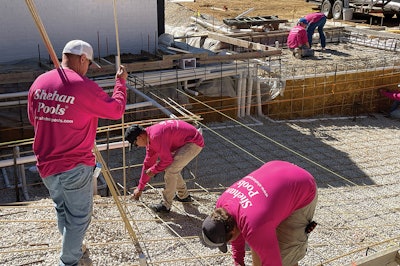 The crew from Shehan Pools working on an 18-by-39-foot gunite pool built using 160 #3 PINKBAR Fiberglas rebar sticks, and 40 #4s, same brand.Photo courtesy Shehan Pools
The crew from Shehan Pools working on an 18-by-39-foot gunite pool built using 160 #3 PINKBAR Fiberglas rebar sticks, and 40 #4s, same brand.Photo courtesy Shehan Pools
New materials and methods for pool building continue to reshape the industry, as companies look for ways of building faster, better, more durable structures. Fiberglass rebar, or more specifically glass-fiber reinforced polymer (GFRP) rebar, is a new player bidding to take market share from steel by offering attractive advantages. This article will examine the pros and cons of GFRP for swimming pools.
Providing firsthand field experience with the product is Bob Shehan, vice president of Shehan Pools, Florence, Kent., a family owned and operated company with over 50 years in the business and a reputation as an innovator.
Shehan Pools started using GFRP last year.
"It's a relatively new product on the market," Shehan says. "It's been used for a while in general construction, but I think we're one of the first to use it in swimming pools. And we were immediately impressed with some of the advantages."
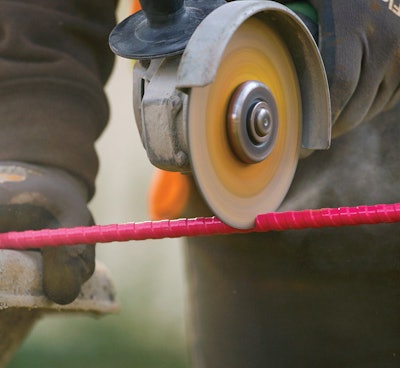 Relatively easy to cut. No sparks.Photo courtesy Owens Corning
Relatively easy to cut. No sparks.Photo courtesy Owens Corning
THE PROS AND CONS OF GFRP REBAR
PROS:
- It's lightweight — GFRP is about 1/4 the weight of steel, making it easy and economical to transport and to handle on jobsites.
Shehan: "My son has actually put 30 pieces of fiberglass rebar up over his head. (But he's a strong lad.) You couldn't do that with steel rebar. You'd be lucky to get three or four pieces, and even that would be a struggle. The point is that just moving fiberglass rebar around the jobsite, or loading it up at the warehouse, that weight difference is a huge benefit. Just the mobility, and getting it in place, it's so much easier."
 Placing concrete over fiberglass.Photo courtesy Owens Corning
Placing concrete over fiberglass.Photo courtesy Owens Corning
- It's non-corrosive — GFRP is ideal for wet or moisture-prone builds. It has a corrosion advantage over regular steel rebar, and may have cost advantages over stainless, galvanized, MMFX (corrosion resistant rebar) or epoxy rebars as well.
Shehan: "One of the huge differences with steel is that fiberglass doesn't corrode, it doesn't oxidize the way steel does. It's true you can use coated steel rebar so it won't rust. That's been around forever, but there are problems with that. You can't use it with gunite because when you spray the gunite, you can knock the coating off."
- The tensile strength of GFRP is twice that of steel rebar. #3 fiberglass is equivalent to #4 steel.
- GFRP offers heat-free handling over steel rebar. (Author's note: This is something I can personally attest to. Handling steel rebar on a blazing summer day is no fun!)
- GFRP is non-conductive, as opposed to steel rebar.
Shehan: "We currently have steel rebar in our pools, so of course, we bond our pool shells, and anything conductive, close to the water's edge — whether that's the steel rebar in the pool, your ladders, your handrails, underwater lights or rebar in the decking around the pool. But looking to the future, we like to be on the cutting edge, so we're looking toward a 100% steel-free pool shell in the next few years."
- Cutting GFRP is straightforward, either with a grinder or demo saw using a diamond blade.
Shehan: "Cutting fiberglass rebar is much simpler and easier. You don't have the sparks flying up like you do when you're cutting steel.
- Plastic cable ties or standard steel tie wire can be used to join GFRP bars. All types of wire can be used as well.
CONS:
- GFRP can be more expensive than steel rebar.
These differences, however, are subject to change as steel is a commodity and pricing is very volatile. In some cases, fiberglass rebar has been the same price or cheaper than steel. Also, suppliers that purchase in large quantities and keep current stock can possibly offer better pricing to contractors. When GFRP is compared to stainless steel rebar, galvanized rebar, MMFX (corrosion resistant rebar) or epoxy rebars, the cost comparison shifts, generally in favor of fiberglass.
- Hard bends, such as 90-degree bends, of GFRP, cannot be made on site.
All custom bends must be made at the factory requiring lead time. Even pre- ordering materials for a build may be problematic, as site conditions and or a change in plans by the homeowner or a GC can delay a project. This is a con for fiberglass compared to steel rebar, which affords a contractor the ability to build "on the fly" when changes are made, as the material is generally readily available.
However, mixing GFRP rebar with steel is acceptable. Full-length bars can be used on floors and horizontal locations with steel bars. Lap splices are performed in the same manner as steel, but the lengths of laps will vary based on its specific design.
Shehan: "We currently use a hybrid system of fiberglass and steel. We're in the process right now of adjusting our procedure toward our goal of a full fiberglass rebar pool in the near future."
A structural engineer at Owens Corning (a leading manufacturer of GFRP) interviewed for this story, said they are producing and stocking GFRP bars with typical bends for swimming pool applications such as hard 90's. Because GFRP is a relatively new material for use in swimming applications, Owens Corning is currently collecting more data to better understand what the most common bends and radii are to enable their production.
Final verdict from Shehan: "Overall, I'm thrilled with this product, and we're going to incorporate it into as many projects as we can. Every year or two, there's a new product that comes to the swimming pool industry that takes over. And this is definitely one of them."
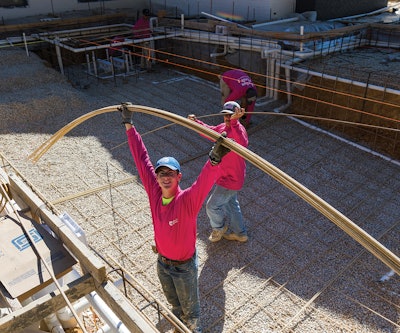 The project shown in this story is being built by Shehan Pools, located in Owensboro, Kent. It's an 18-by-39-foot gunite pool built using 160 #3 PINKBAR Fiberglas rebar sticks, and 40 #4s, same brand. The pool is built using a steel-fiberglass hybrid system using some steel rebar. Here, Aaron Shehan demonstrates the weight advantage of fiberglass rebar.Photo courtesy Shehan Pools
The project shown in this story is being built by Shehan Pools, located in Owensboro, Kent. It's an 18-by-39-foot gunite pool built using 160 #3 PINKBAR Fiberglas rebar sticks, and 40 #4s, same brand. The pool is built using a steel-fiberglass hybrid system using some steel rebar. Here, Aaron Shehan demonstrates the weight advantage of fiberglass rebar.Photo courtesy Shehan Pools
CODE CONSIDERATIONS
Per the NEC (National Electrical Code) 680.26(B)(1)(b), the entire contour of a concrete swimming pool, because of its porous nature, is considered conductive, and therefore, steel rebar must be bonded. When using GFRP, it must have a copper bonding grid in place. This includes any area where the GFRP is placed within the entire structure. Along the same line, epoxy- coated rebar, an encapsulated rebar, must also conform to the same code requirements.
This contour bonding requirement will add additional costs of materials and labor. A copper bonding grid is expensive and, like steel, is also a commodity that is subject to price fluctuations.
This may be of concern for builders, as it's a significant cost increase on any size build.
GFRP can be advantageous for pool decks, as there is no need for it to be bonded. However, NEC does require a perimeter bond to be located 18 to 24 inches from the inside of a pool beneath the patio surface on concrete structures.
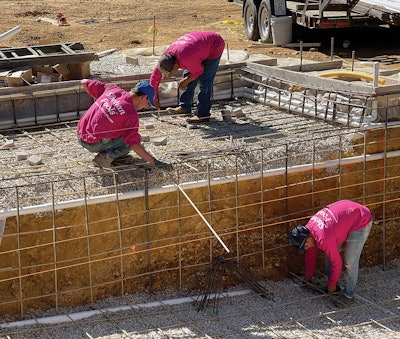 The crew from Shehan Pools placing and tying up rebar, using standard procedures for tying. Note the use of steel rebar for 90-degree bends and transitions, while the long runs of straight rebar are fiberglass. "We currently use a hybrid system of fiberglass and steel," says Bob Shehan. "We're in the process right now of adjusting our procedure toward our goal of a full fiberglass rebar pool in the near future."Photo courtesy Shehan Pools
The crew from Shehan Pools placing and tying up rebar, using standard procedures for tying. Note the use of steel rebar for 90-degree bends and transitions, while the long runs of straight rebar are fiberglass. "We currently use a hybrid system of fiberglass and steel," says Bob Shehan. "We're in the process right now of adjusting our procedure toward our goal of a full fiberglass rebar pool in the near future."Photo courtesy Shehan Pools
According to Owens Corning, #3 PINKBAR (a registered trademark of Owens Corning) is a direct replacement for #4 steel rebar in flatwork applications requiring reinforcement for shrinkage crack mitigation. Design considerations for swimming pools, though, require precise calculations to indicate rebar sizes and placement. These calculations, and any plans generated, must be performed by a professional structural engineer.
PINKBAR is roughly 2x the tensile strength compared to steel rebar. However, it does have a lower modulus of elasticity, the unit of measurement of an object's or substance's resistance to being deformed elastically (i.e., non- permanently) when stress is applied to it.
Owens Corning states these guidelines for use of GFRP on swimming pools:
- The #3 PINKBAR Fiberglas Rebar (the word "Fiberglas" is trademarked by the company) should be spaced at 3x the intended thickness of the pool walls or a maximum spacing of 12 inches, whichever is less for walls 6 inches thick or less. Use #4 size as the walls get thicker than 6 inches. This satisfies the ACI 440 code requirements for temperature and shrinkage reinforcing.
- When an engineering stamp is required to satisfy code authorities, refer to ACI 440.11-22 from the American Concrete Institute for guidance.
GFRP has some impressive attributes and perhaps will become more acceptable as an alternative to steel reinforcement bars for swimming pools in the future. Ultimately, the choice between GFRP rebar or steel rebar in concrete structures will come down to a balance of costs versus benefits for your unique application.
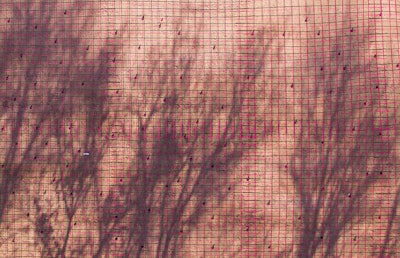 A bird's-eye view of a fiberglass rebar layout.Photo courtesy Owens Corning
A bird's-eye view of a fiberglass rebar layout.Photo courtesy Owens Corning












































